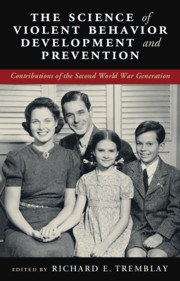 The Science of Violent Behavior Development and Prevention
The Science of Violent Behavior Development and Prevention Book contents
- The Science of Violent Behavior Development and Prevention
- The Science of Violent Behavior Development and Prevention
- Copyright page
- Contents
- Preface
- 1 Introduction: A Young Science with a Long History
- 2 From Birth in a British Orphanage to Assessments of American Indians’ Development
- 3 From Rationing, Illness, and Stress to the Creation of a Major Longitudinal Birth Cohort
- 4 From Country Girl in Southern Finland to Longitudinal Research into Alternatives to Aggression and Violence
- 5 From the Occupied Netherlands to the Pittsburgh Longitudinal Studies
- 6 From Boy to Man
- 7 Nurture and Nature
- 8 From Unruly Child to Political Protester and Promoter of an Ecology-Minded Concept of Development
- 9 From the Frustration–Aggression Hypothesis to Moral Reasoning and Action
- 10 A Tortuous Path towards Understanding and Preventing the Development of Chronic Physical Aggression
- 11 From Childhood in a Ruined German City to Research on Crime and Violence
- 12 The Last War Baby
- 13 Comments on the Autobiographies of the World War II Babies by Younger Peers
- Index
- References
4 - From Country Girl in Southern Finland to Longitudinal Research into Alternatives to Aggression and Violence
Published online by Cambridge University Press: 28 January 2021
- The Science of Violent Behavior Development and Prevention
- The Science of Violent Behavior Development and Prevention
- Copyright page
- Contents
- Preface
- 1 Introduction: A Young Science with a Long History
- 2 From Birth in a British Orphanage to Assessments of American Indians’ Development
- 3 From Rationing, Illness, and Stress to the Creation of a Major Longitudinal Birth Cohort
- 4 From Country Girl in Southern Finland to Longitudinal Research into Alternatives to Aggression and Violence
- 5 From the Occupied Netherlands to the Pittsburgh Longitudinal Studies
- 6 From Boy to Man
- 7 Nurture and Nature
- 8 From Unruly Child to Political Protester and Promoter of an Ecology-Minded Concept of Development
- 9 From the Frustration–Aggression Hypothesis to Moral Reasoning and Action
- 10 A Tortuous Path towards Understanding and Preventing the Development of Chronic Physical Aggression
- 11 From Childhood in a Ruined German City to Research on Crime and Violence
- 12 The Last War Baby
- 13 Comments on the Autobiographies of the World War II Babies by Younger Peers
- Index
- References
Summary
Lea Pulkkinen, born in Finland in 1939, is Emerita Professor of Psychology at the University of Jyväskylä (Finland). She is best known for creating the ongoing Jyväskylä Longitudinal Study of Personality and Social Development (JLSPSD). The study was specifically intended to test the hypothesis that the human brain allows for more variation in behavior than the simple ‘fight or flight’ response observed in animal studies of aggression. She further hypothesized that humans’ capacity for cognitive control over emotional behavior was the key factor involved in controlling aggressive behavior. These hypotheses led her to devise an impulse control model to depict behavioral alternatives, which she tested with teacher and peer ratings of aggressive and nonaggressive behaviors. Forty years later, the JLSPSD revealed the long-term significance of self-regulation for socio-emotional behavior. Results from the study showed that aggressive behavior during childhood tends to be associated with other types of under-controlled behavior during adulthood. On the other hand, ‘constructive’ behavior in childhood tends to lead to positive social relations, mental health, and successful integration in the work force.
Keywords
- Type
- Chapter
- Information
- The Science of Violent Behavior Development and PreventionContributions of the Second World War Generation, pp. 71 - 94Publisher: Cambridge University PressPrint publication year: 2021
